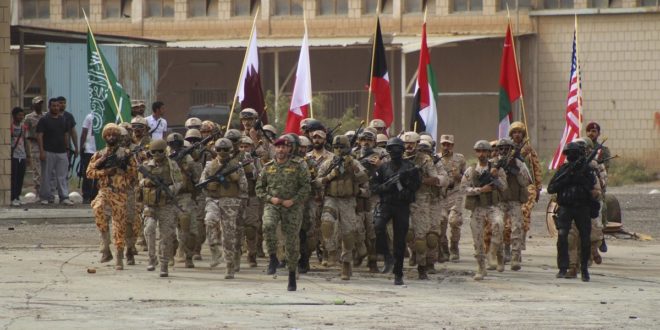Shehab Al-Makahleh
January 17th marks the 26th anniversary of the First Gulf War to liberate Kuwait from Iraqi forces. On this day in 1991, the United States has led a coalition against Iraqi by launching a massive military operation that paved the way for shaping a new world order with a new generation of weapons such as cruise missiles tracking targets in Iraq.
Former Iraqi President Saddam Hussein’s fault was his expansionist agenda, which has had devastating results on the Iraqi military. Though the Americans had deployed thousands of their forces in many states in the region after the first Gulf War, this has not helped secure Gulf States from any external threat including the Iranian menace.
Since 1991, military balance in the Middle East and in the Gulf region has changed entirely. At the beginning of Iraq’s invasion of Kuwait, Iraq was by far the dominant military power in the Middle East region and its army was considered among the top 10 armies in the world. It had determinedly defeated Iran in 1988 after eight years of war.
After the fall of Saddam Hussein in 2003, the Gulf States started thinking of making power balance with Iran as the Americans dissolved the Iraqi army. Thus, Gulf States started thinking of arming themselves with strategic weapons.
Since the Second Gulf War in 2003, it has become clear that the UAE and Saudi Arabia have taken the lead to heavily arm their forces. Therefore, from a strategic perspective, both Riyadh and Abu Dhabi have been investing in costly and sophisticated weaponry and in training their forces, providing them with state-of-the-art arms and localising maintenance and domestic defense industry.
The Middle East in general and the Gulf region in particular are one of the most militarized regions in the world, with copious encounters or logjams that embroil approximately every state in the region. Gulf armed forces are steadily leaving the conventional army models by embracing a gallant military configuration, combining imported prognostication and nationwide mobilization and deployment through introducing military conscription and competitive edge of weapons over Iran to create a state of deterrence of any external threat including the Iranian.
Thus, if the issue of the political rift between Iran and other countries of the region continue, two scenarios are inevitable in the Arabian Gulf. This means the world has to be ready for two possible developments that would instigate tensions in the Middle East.
Iran is viewed as a threat not just by the US or Israel, but also by the Gulf states, except Oman. Unending conflicts in countries such as Yemen, Syria, and Libya reveal the extent to which other countries seek to affect upshots by using their own military forces and through arms transfers to local partners such as in the case of Yemen.
Many countries in the region face transnational terrorist threats and, in some states, inland insurgencies. Thus, the Middle East and the Gulf region have participated to a great extent in the global arms trade, constituting 63 percent of the value of all arms deals concluded by all suppliers with the developing world from 2013 – 2016, and 55 percent from 2009 -2012 as per military statistics.
Scenario I: Dispute over Iran’s nuclear program
Tensions between the US and Israel on one hand and Iran on the other with regard to Iran’s nuclear program could increase. This would exacerbate tension between the Gulf States and Iran if both the US and Israel, jointly or individually, launch a pre-emptive attack on Iranian nuclear facilities, making the Gulf States a potential target for Iranian retaliation or retribution.
The Iranian response will be through the use of short-range and medium-range missiles, the use of secret cells in the Gulf States, the use of its new arsenals with warheads, and the deployment of its navy in the Gulf waters and the Strait of Hormuz to disrupt maritime trade and navigation in the Gulf, where Iran will attack commercial vessels and close the Strait where more than 17 million barrels of oil per day pass through the strait.
According to American Energy Information Administration (EIA), the 17 million barrels of oil, represent 30 percent of all maritime-traded petroleum, passed through the strait each day. Oil from Saudi Arabia, the UAE, Qatar, Iran, and Iraq all pass through the strait and head mostly towards Asia, Europe and America.
Whatever the form of the US attack on Iran would be, Iranian retaliation will focus on attacking many American military bases in the region, mainly in Bahrain, Qatar, Saudi Arabia and the UAE.
However, the threat of Iranian vengeance can be absorbed and mitigated by developing missile defense capabilities in the Gulf States by focusing on the command, control and communication systems. The Gulf States should also cooperate with each other to develop security and maritime counterterrorism capabilities in cooperation with the US and NATO.
Scenario II: Short-term conflict
In the absence of an open conflict between the US and its allies on one hand and Iran on the other, Tehran could use covert relations with Shi’ite groups in the region to exercise more pressure on the US and Saudi Arabia or their allies. If instability continues in Yemen, Iran will continue to support factions and clandestine cells through its military arm and militias.
Iran may also continue to benefit from its support to the Houthis, and perhaps al-Qaeda in the Arabian Peninsula, to put more pressure on Washington and Riyadh as well as Abu Dhabi to pull out of Yemen. This can be dealt with arms deals between the GCC states and the USA as means of partnership.
The US has recently increased its arms sales under partnership agreements with the GCC by more than 8 times between 2004-2007 and 9 times during 2008 – 2011. Saudi Arabia had the largest share of these deals, an increase of 9 times. Saudi Arabia was the world’s second largest arms importer in 2012-16, with an increase of 212 percent compared with 2007–2011.
Arms imports by Qatar went up by 245 percent, according to Stockholm International Peace Research Institute (SIPRI). The State of Kuwait, the Sultanate of Oman and the UAE have also experienced significant growth in US arms deals. The Gulf States have been able to obtain quality weapons for the missile defense system.
United States has cemented its bilateral relations with the Gulf countries for the security and stability of the region. There is no doubt that the GCC States face fundamental challenges and threats in a turbulent territory, as was the case with Iraq’s invasion of Kuwait in 1990 and Iran’s continued occupation of the three Emirati islands.
The coming few years are very detrimental for many countries due to the change in political games and alliances. The competitive edge would be more alliances, more sophisticated weapons and military technology transfer as well as regional and international cooperation to counter terrorism.
_________________________
Shehab Al-Makahleh is Director of Geostrategic Media Center, senior media and political analyst in the Middle East, adviser to many international consultancies. He can be reached at: @shehabmakahleh and @Geostrat_ME.
Originally published by Al Arabiya English
 Geostrategic Media Political Commentary, Analysis, Security, Defense
Geostrategic Media Political Commentary, Analysis, Security, Defense





